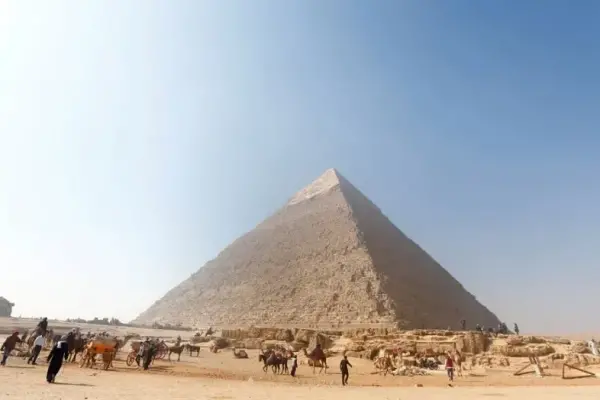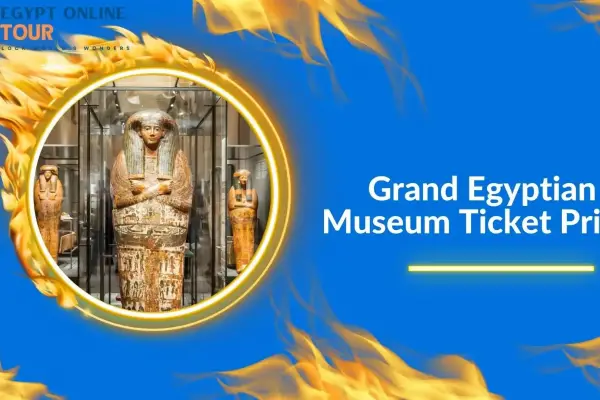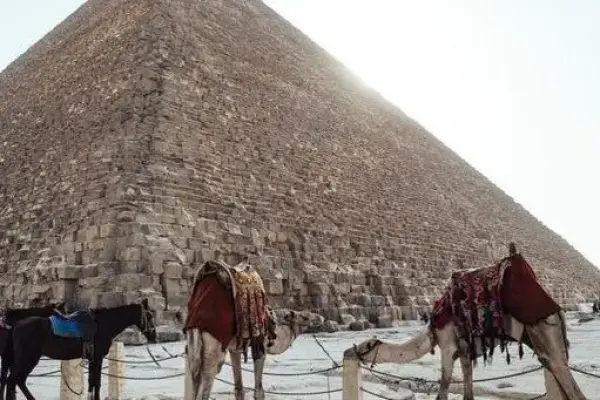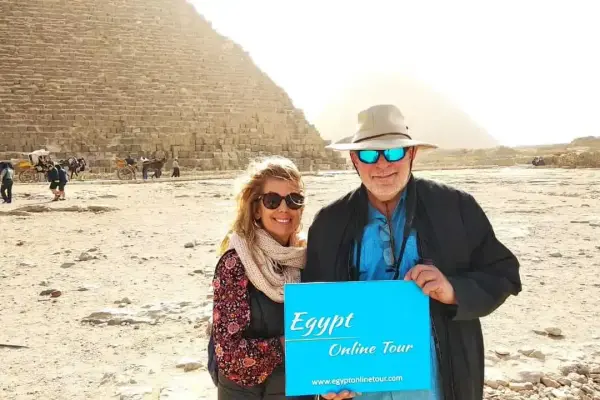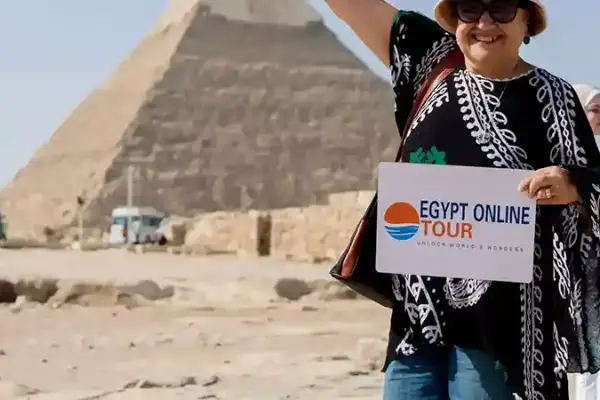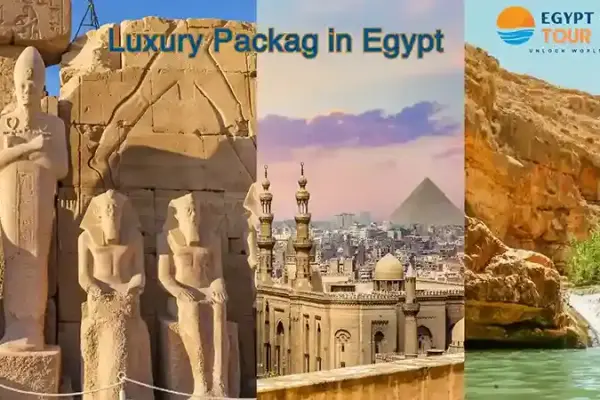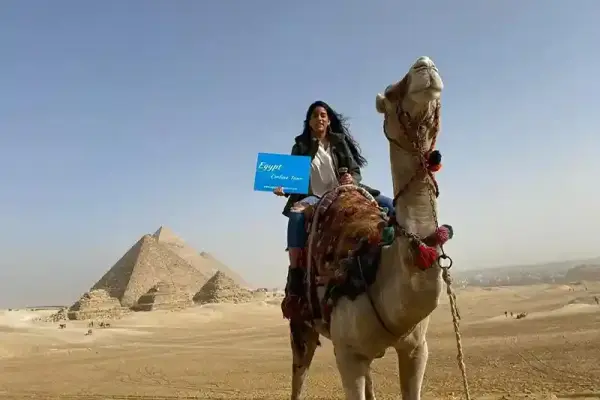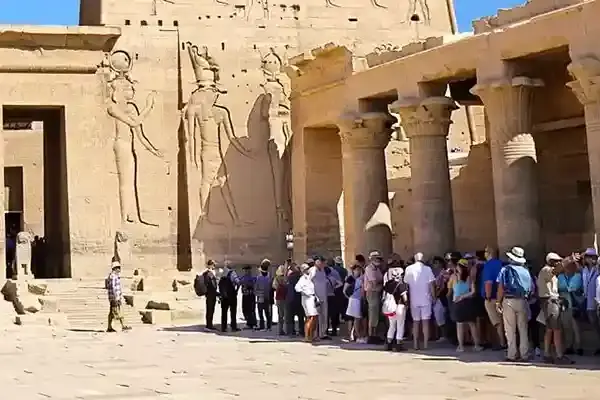The Pyramid of Menkaure, the smallest of the three famous pyramids of Giza, is an architectural gem that complements the grandeur of this archaeological complex. This pyramid was built for King Menkaure, son of King Khafre, during the Fourth Dynasty (ca. 2500 BC), to be a place for his eternal rest and journey to the afterlife. Although small in size compared to the pyramids of Khufu and Khafre, it is distinguished by its unique style and use of pink granite in its lower cladding, reflecting a development in ancient Egyptian funerary architecture and doctrine.
Table of contents [Show]
- Pyramid of Menkaure at a Glance
- Fast Facts and Dimensions
- History and Builder
- Architecture and Materials
- The Pyramid Complex
- Inside the Pyramid: What to Expect
- Tickets, Hours, and Best Time
- Photography and Safety Tips
- Menkaure vs. Khafre and Khufu
- Latest Research and Curiosities
- Plan Your Visit Route
- Why choose Egypt Online Tour to arrange your tour to the Giza pyramids?
Pyramid of Menkaure at a Glance
The Pyramid of Menkaure (known as the "Divine Menkaure") is a testament to the legacy of King Menkaure, who ordered its construction around 2510 BC, to be the last of the great pyramids of the Fourth Dynasty. This pyramid is the smallest of the Giza pyramids, and its limited size is attributed to the deteriorating economic conditions that prevailed at the end of that dynasty.
Smallest of Giza’s trio, big on uniqueness
The Pyramid of Menkaure is a testament to ancient Egyptian engineering skills and an important reminder of their rich history and culture. It is one of the most impressive monuments in Egypt due to its size and complexity. She Although it may not be as large or impressive as its neighbors, it remains one of the most famous monuments in Egypt today.
Read about: Is The Sphinx Older Than The Pyramids
Where it sits on the Giza Plateau
The Pyramid of Menkaure is located on the west bank of the Nile River in the Giza Cemetery in Egypt. It is the smallest of the three pyramids in Giza and was built for Pharaoh Menkaure, who ruled from 2490 to 2472 BC. It is believed to have been built around 2530 BC and is estimated to have taken about ten years to build.
The pyramid was originally covered with white limestone casing stones, which stone thieves removed over time. This made the pyramid look much different than it did when it was first built. Today only a few casing stones remain on the outer walls of the pyramid.
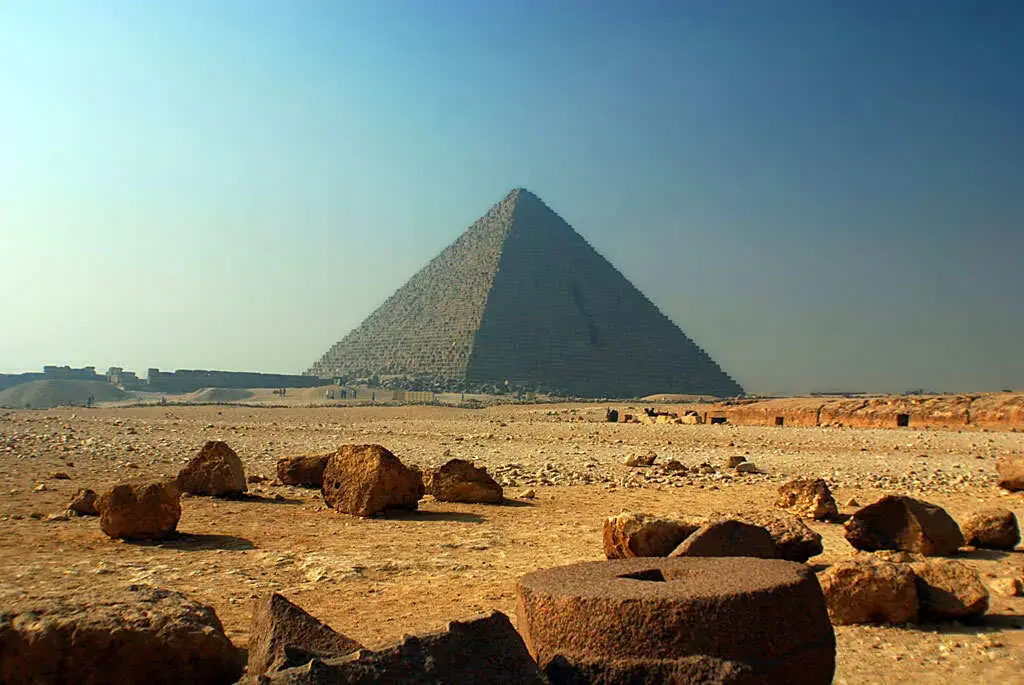
Fast Facts and Dimensions
Fact | Details |
Name | Pyramid of Menkaure (Pyramid of Mykerinos) |
Location | Giza Plateau, near Cairo, Egypt |
Dynasty | Fourth Dynasty, Old Kingdom |
Builder | Pharaoh Menkaure, son of Khafre |
Construction Date | Circa 2530 BC |
Original Height | 66 meters (216 feet) |
Current Height | 62–65 meters (203–213 feet) |
Base Length | 102.2 meters (335 feet) |
Materials | Core of limestone, lower casing of granite from Aswan |
Purpose | Royal tomb and symbol of divine kingship |
- If you want to know more about the Facts About Ancient Pyramids in Egypt , click the link for more details.
Height, base, and slope compared to Khufu and Khafre
The Pyramid of Menkaure is the shortest of all the pyramids at 65.5 metres (215 ft). The Pyramid of Menkaure is 61 meters (204 ft) high, and its base is 108.5 meters at an angle of 51°20'25.
What makes the granite casing distinctive
The Pyramid of Menkaure was built using granite and limestone. The Pyramid of Menkaure is distinguished by its red granite casing and modest size and was designed to house Menkaure's granite sarcophagus in its center, making it a stunning example of ancient Egyptian architecture and engineering. Its unique design and durable granite casing demonstrate the ingenuity of ancient Egyptian builders and ensure its permanent place among the world's great monuments. Its unique design has also allowed it to stand firm in the face of time while still providing an impressive display for visitors who admire its beauty today.
History and Builder
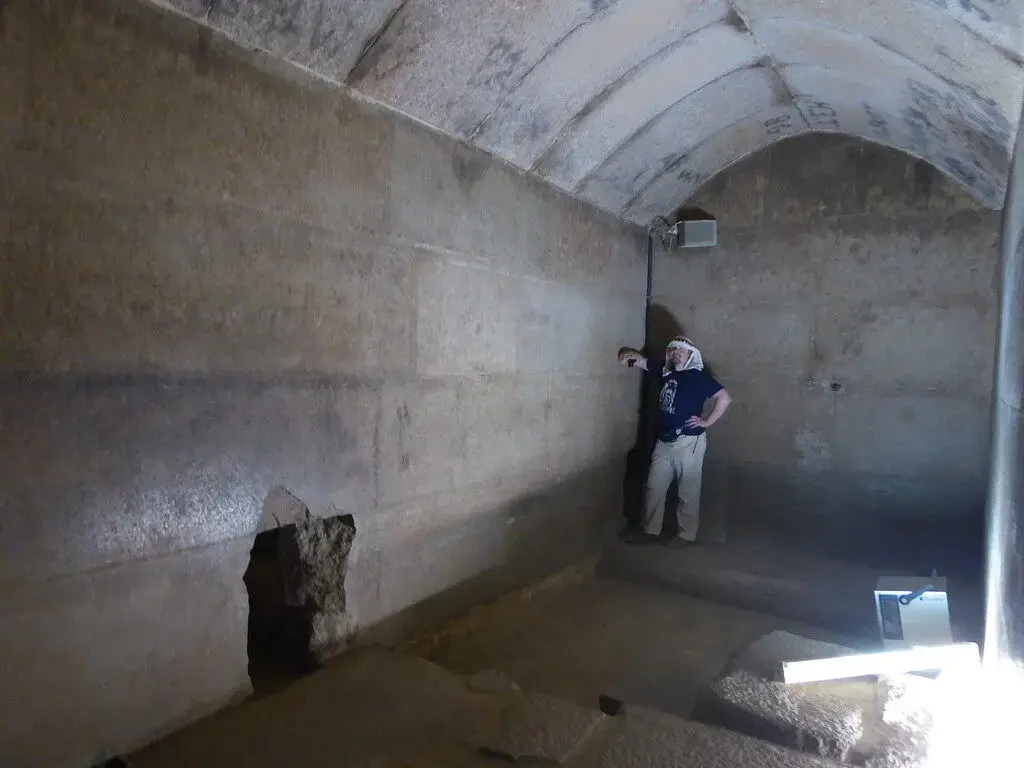
This pyramid was built for King Menkaure, son of King Khafre, during the Fourth Dynasty (ca. 2500 BC), to be a place for his eternal rest and journey to the afterlife.
Who was King Menkaure, and what was his legacy
Pharaoh Menkaure, also known as King Menkaure, was the fifth king of the Fourth Dynasty of Egypt, the son of Khafre and the grandson of Khufu. His reign in the 26th century BC was marked by prosperity, cultural growth, and the construction of the Pyramid of Menkaure, the smallest of the three pyramids on the Giza Plateau. Remembered as a just and easy-going ruler, he left a legacy that goes beyond his much smaller pyramid: elegant royal statues and iconic triads that embody the spirit of Old Kingdom art.
Read about: Did Thoth Build the Pyramids
Construction timeline and Old Kingdom context
Construction of the Pyramid of Menkaure began around 2560 BC and was completed around 2532 BC.
Menkaure's pyramid was not only smaller than its predecessors but also less complex in design, perhaps due to the fact that construction began later during Menkaure's reign than during the reigns of his father and grandfather. Some scholars have suggested that the simpler design may have been due to a change in religious beliefs during this time, but this is speculative.
Architecture and Materials
The Pyramid of Menkaure is the shortest of all the three at 65.5 meters (215 ft). The Pyramid of Menkaure is 61 meters (204 ft) high, and its base is 108.5 meters at an angle of 51°20'25.
Granite lower courses and Tura limestone upper casing
The Pyramid of Menkaure was built using granite and limestone. The first 16 courses on the outside were made of red granite, while the upper part was completely covered with Tora limestone. The pyramid's construction was characterized by the first sixteen layers using red granite, while the upper section was covered with Tora limestone, leaving some granite unfinished. The pyramid was intended to serve as Pharaoh Menkaure's final resting place and represents a powerful example of the pharaoh's rule. These unfinished items provide valuable insights for archaeologists studying ancient building techniques for both pyramids and temples.
There is a group of three satellite pyramids south of Menkaure's main pyramid, accompanied by a temple and infrastructure and partially covered with granite.
Interior plan: descending passage and burial chamber
The entrance was about four meters above ground level, leading to descending corridors and rooms with niches. The waiting room contained a human-shaped coffin with human bones, likely inserted during later periods. A granite corridor leads to the burial chamber, oriented differently from the pyramids of Khufu and Khafre and completely covered in pink granite with a domed roof. It is believed that this room, along with the niches, was built after Menkaure's death, perhaps on the orders of his successor. The western wall of the burial chamber contained a basalt coffin that was lost at sea while being transported to the British Museum.
The Pyramid Complex

The pyramid complex also features three subsidiary pyramids built for queens, along with an adjoining mortuary temple
Queens’ pyramids and satellite structures
South of Menkaure's pyramid, three smaller pyramids were found with their accompanying temples and infrastructure. The eastern pyramid, a real pyramid with a granite casing, is believed to have been completed, while the other pyramid only reached the construction of the inner core. These structures may have been tombs for the queens of Menkaure or served as a Ka pyramid housing a statue of the king. The presence of a pink granite sarcophagus suggests that it could be reused for the queen's burial or as a chapel for Menkaure's mummification.
There is a group of three satellite pyramids south of Menkaure's main pyramid, accompanied by a temple and infrastructure and partially covered with granite.
Valley temple, causeway, and mortuary temple
The Temple of Wadi Menkaure was excavated, thus discovering many statues of Menkaure individually and in groups, made in the natural Old Kingdom style with intricate details.
The mortuary temple of Pharaoh Menkaure was built with limestone foundations and an inner core featuring granite floors and facades on some walls. The weight of local stone blocks in the temple walls amounted to about 220 tons, while the weight of granite stones imported from Aswan exceeded 30 tons. Menkaure's successor, Shepseskaf, likely completed the temple, as evidenced by an inscription expressing his devotion to his father. The temple saw later architectural additions, indicating that the pharaoh's cult continued or was periodically renewed for two centuries after his death.
Let our local travel experts help you design the perfect itinerary. Whether you're seeking adventure, culture, or relaxation, we've got you covered!
Inside the Pyramid: What to Expect
The Pyramid of Menkaure is distinguished by its unique style, but what do you expect inside it?
Access, steep passages, and chamber layout
Through radiocarbon dating, the bones were determined to be less than 2,000 years old, indicating mishandling of the remains or accessibility of the pyramid during ancient Roman times.
Entering the pyramid involves navigating through narrow, steep passages, which can be difficult for individuals with mobility issues or claustrophobia.
The interior of the pyramid was carefully designed to contain rooms and corridors. The main burial chamber was built of granite and may have contained the pharaoh's coffin like the rest of the Pyramid of Giza.
The main burial chamber was built of granite and may have contained the pharaoh's coffin, like the rest of the Pyramid of Giza.
Read about: Can You Go Inside The Great Pyramids
Claustrophobia tips and crowd patterns
Do not go inside if you suffer from claustrophobia. You can get in but it's not easy. You have to bend at the waist for a while and then open up more space halfway up. The upper room is empty except for the coffin.Go inside if you suffer from claustrophobia. You can get in but it's not easy. You have to bend at the waist for a while and then open up more space halfway up. The upper room is empty except for the coffin.
Visitors are advised to go early to avoid crowds, especially since it is the smallest of the three main pyramids of Giza and can be crowded. The pyramid is one of the famous tourist attractions on the Giza Plateau.
Read about: Pyramids were most popular during which of the following periods
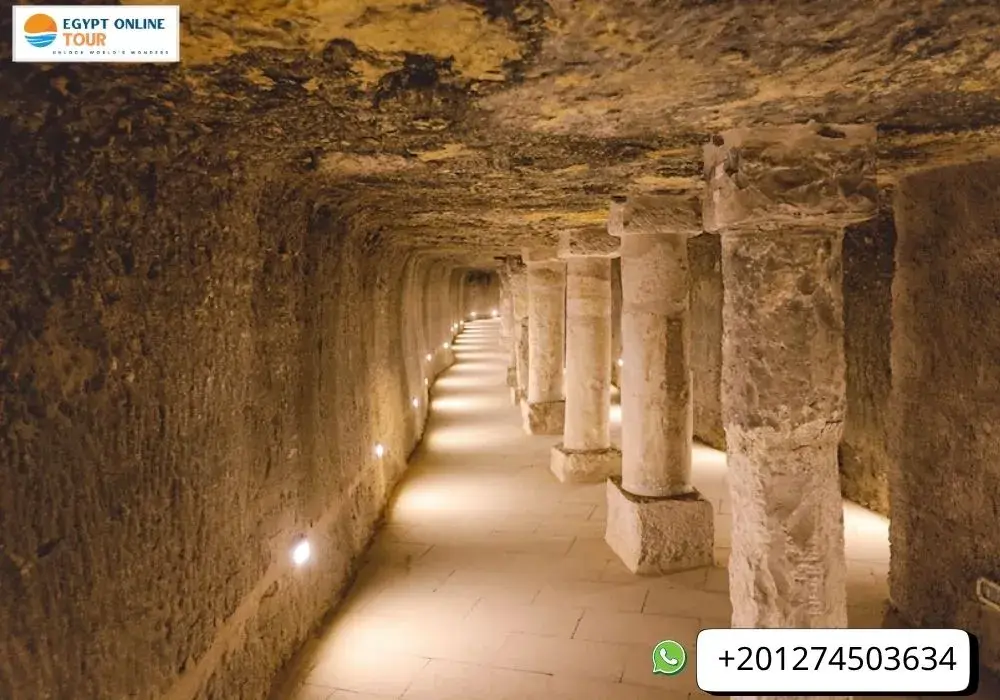
Tickets, Hours, and Best Time
Having a private tour guide will help you get rid of the hassle of moving around the Giza Plateau, negotiating prices, booking camel rides, buying tickets, and anything else.
The best time to visit the pyramids, depending on the season, is always winter, from September to March, when the climate becomes very comfortable! For the best experience, plan your pyramid visit early in the morning to enjoy cooler weather and fewer tourists
Discover our Luxury Egypt Tours .
Giza Plateau hours and entry rules
Individuals | Ticket Prices
|
Egyptian and Arab:
|
|
Other Nationality:
|
|
Opening Hours: All Days
Summer Working Hours: from 07:00 am, with last entry at 04:00 pm
Winter Working Hours: from 07:00 am, with last entry at 04:00 pm
Ramadan Working Hours: from 08:00 am, with last entry at 03:30 pm
Menkaure interior ticket price and availability
Note: This price is for entry to the Pyramid of Menkaure itself and is separate from the general entry ticket to the Giza Plateau.
The Pyramid of Menkaure is generally open from 8:00 a.m. to 4:00 p.m., with the last entry at 3:00 p.m., although opening hours can vary.
Photography and Safety Tips
Photography Tips:
Use a wide-angle lens or panoramic mode to capture the full range. Include foreground elements such as desert rocks or camel shadows for depth. The location offers opportunities for 360-degree photography, so explore different angles beyond the standard configuration.
Safety tips:
- The pyramid’s area is often crowded, especially during peak tourist seasons.
- To avoid large crowds, it is best to arrive as soon as possible.
- Walking is a good option for those with the time and energy, as camel and carriage rides can be expensive.
Is it Safe to Visit Pyramids of Giza ? Click the link to be rest assured.
Lighting, heat, and footwear recommendations
The Pyramid of Menkaure, along with other pyramids of Giza, has been upgraded with a new environmentally friendly indoor lighting system using LED technology. In addition, there is a separate outdoor sound and light show held at night, using colorful lights and audio narration to tell the history of the pyramids and ancient Egypt
Although they are located in the hot climate of Egypt, the inside of the pyramids tends to remain relatively cool, thanks to the thick stone walls, which insulate against external temperatures.
Most recommend closed-toe shoes for comfort and safety. You definitely want closed-toe, walking, and athletic shoes.
Suggested article: Can You Go Inside The Great Pyramids
Respectful conduct inside ancient spaces
If you have the opportunity to visit the pyramids, you must be respectful and responsible. You should refrain from touching, climbing, or defacing historic structures.
Menkaure vs. Khafre and Khufu
There are key differences between the interiors of the the Menkaure, Khafre, and Khufu pyramids.
Which interior to choose and why
The pyramids of Khafre and Menkaure are smaller, cheaper, and usually less crowded than the Great Pyramid. As with the Great Pyramid, there isn't much to see inside, but if you prefer smaller crowds, consider visiting one of these two pyramids.
Viewpoints and best photo angles
In front of the Sphinx, there is a large open sandy area, which is the perfect place for a photo shoot. This is also a great place to photograph the sunset.
Reveal the secret: Is The Sphinx Older Than The Pyramids
Latest Research and Curiosities
Recent research on Pharaoh Menkaure has focused on non-destructive exploration of his pyramid and new interpretations of his famous temple complex and statues.
Anomalies and recent investigations
The images revealed two anomalies directly behind the polished granite blocks, indicating air-filled voids. This interpretation was supported by a series of numerical simulations that considered several possible scenarios under real-world conditions.
The northern gash and 12th‑century demolition attempt
The pyramid has gone through an unsuccessful attempt. At the end of the twelfth century, King Al-Aziz Othman bin Yusuf, son and heir of Saladin, tried to demolish the pyramids, starting with the pyramids of Menkaure. The workers recruited by Al-Aziz to demolish the pyramid found that the cost of destroying it was almost equal to the cost of building it. They stayed at work for eight months. They were unable to remove more than one or two stones every day at the cost of completely exhausting themselves. Some used pegs and levers to move the stones, while others used ropes to pull them down. When a stone falls, it buries itself in the sand, requiring extraordinary efforts to free it. Pegs were used to divide the stones into several pieces, and a cart was used to carry them to the foot of the slope, where they were left. Far from achieving what they intended to do, they only ruined the pyramid by leaving a large vertical gash on its northern side.
Read about: What countries have pyramids- Know the full detalis
Plan Your Visit Route

The following suggestion will help you enjoy a magic tour around the plateau.
Suggested order around the plateau
A typical tour of the Giza Plateau includes the following order:
Great Pyramid of Khufu: Start your tour with the oldest and largest of the three main pyramids. This allows you to experience the site chronologically and estimate the size of the different monuments.
Pyramid of Khafre and Sphinx: Continue south to the Pyramid of Khafre. The Great Sphinx is part of the Khafre Pyramid Complex, and the Sphinx Temple is located in the Khafre Valley Temple, making it the next natural stop.
You may be interested in learning When Was the Great Sphinx Built .
Pyramid of Menkaure and its complex: The Pyramid of Menkaure is the southernmost of the three main pyramids. Its recent visit gives a sense of completeness.
The Menkaure complex includes several important features:
Pyramid: Although the smallest, Menkaure's Pyramid is famous for its distinctive red granite casing on the lower levels.
South of Menkaure's pyramid are three smaller, unfinished pyramids believed to belong to his queens.
Funerary Temples and Valley Temples: The funerary complex also includes the ruins of funerary temples and valley temples. You can see the remains of the mortuary temple courtyard.
Bridge: The remains of the bridge connecting the two temples are also part of the complex.
Tips for your visit
Camel or Horse Riding: Riding a camel or horse between the pyramids of Khafre and Menkaure will give you a great opportunity to take photos and provide some walking. The area around Menkaure offers expansive desert views for photos.
Avoid crowds: Visit early in the morning to avoid high afternoon temperatures and heavy tourist traffic, especially during the summer.
Guided Tour: Hiring a local guide or Egyptologist will greatly enhance your experience by providing historical context and details about each site. Learn more about Egypt Classic Tours .
Stay hydrated: The Giza Plateau is an open and exposed area. Keep plenty of water with you, wear a hat, and use sunscreen.
Combine with Sphinx and Solar Boat sites
There are conceptual (symbolic) and geographical relationships between Sphinx and Solar Boat sites.
Conceptual (symbolic) relationship
Both monuments are associated with the worship of the sun god Ra and the eternal journey in ancient Egyptian doctrine:
Solar boat (sun boat):
Its main purpose was to represent the means that the deceased king (Khufu) would use to sail with the sun god Ra on his daily journey across heaven (day) and the world of the dead (night), to ensure resurrection and eternal life.
It is an essential part of the funerary rituals related to the solar resurrection of the king.
Sphinx:
The Sphinx, especially in the New Kingdom, was closely associated with the solar god Hor-em-akht (Horus on the horizon).
It represents the guardian of the cemetery, and faces east (the direction of sunrise) to symbolize the rising sun and rebirth.
Egyptologist Zahi Hawass points out that the location of the Sphinx and the architecture of the area show "the sun god Ra at sunrise and sunset between the two pyramids."
In short: The solar boat is the king's means of participating in the sun's journey (symbolized by the Sphinx guarding the direction of sunrise).
Discover What is in the Sphinx of Egypt .
Geographical relationship and common location
Both the Solar Boat (which houses Khufu's boat) and the Sphinx are located in the Giza Archaeological Area, and both are located in the vicinity of the pyramids of Khufu and Khafre.
The Solar Boat is located near the Great Pyramid, and the Sphinx is also located on the plateau itself, making them part of a single funerary and ritual complex for the kings of the Fourth Dynasty.
Why choose Egypt Online Tour to arrange your tour to the Giza pyramids?
If you choose Egypt Online Tour for your Egypt tour packages , you will embark on an unforgettable tour through time.
- We are your trusted partner and leading organizer to explore the pyramids and monuments of Giza.
- We don't just offer a tour but rather take you on an immersive and integrated experience, ensuring you enjoy visiting the three pyramids and the Sphinx with an exceptional and profound view.
- With our unparalleled experience and certified tour guides specializing in Egyptology, we guarantee you a comprehensive understanding of every mystery and story behind these timeless wonders.
- With us, you will discover the magic and reach the heart of ancient Egyptian civilization, where comfort, professionalism, and memories last forever.
Are you ready for an exceptional tour with Egypt Online Tour? Contact us now.
Let our local travel experts help you design the perfect itinerary. Whether you're seeking adventure, culture, or relaxation, we've got you covered!
Frequently Asked Questions
1 What is special about the Menkaure pyramid? ▶
2 Why is there a hole in the pyramid of Menkaure? ▶
3 What was found inside Menkaure's pyramid? ▶
4 Why does the pyramid of Menkaure have a gash on its side? ▶
5 Why are the pyramids not white anymore? ▶
Popular Categories
Popular Posts

Top Alexandria Beaches You Must Visit 2026

What are the important holidays in Egypt?
